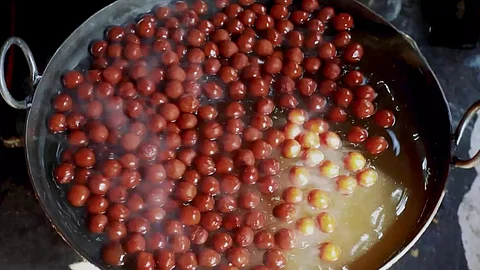
- HOMEGROWN WORLD
- #HGCREATORS
- #HGEXPLORE
- #HGVOICES
- #HGSHOP
- CAREERS
- ABOUT US
- CONTACT US

If you’re traveling along National Highway 24 between Delhi and Lucknow, there’s a sweet surprise awaiting you in the quiet village of Maigalganj. This small village in Uttar Pradesh is famous not for its size, history, or landmarks, but for one thing: gulab jamun. Lining the highway, more than a hundred shops, squeezed into a small stretch, have built their reputation on this iconic dessert.
Gulab jamuns, those rich, spongy balls of fried dough soaked in syrup, have a permanent place in our celebrations, from weddings to festivals. But in Maigalganj, they’re available year-round, with every shop offering its unique rendition of this beloved treat. How this village became a hub for gulab jamun remains a mystery, but what’s clear is the deep-rooted tradition and affection for the dessert that has sustained these shops for decades.
The sweet saga began in 1941, when a vendor named Dhanpal set up the first gulab jamun shop in the area. At the time, the roads weren’t developed, and the village was relatively isolated. Yet, travelers along the route discovered the delectable dessert, and its fame began to spread. As more shops popped up, Maigalganj slowly became synonymous with this confectionery, eventually being dubbed Gulab Jamun Street.
Behind each gulab jamun lies a meticulous process. The dessert is made using khoya (milk solids) mixed with flour and a dash of baking soda, kneaded into dough, and shaped into small balls. These are then fried in clarified butter until golden brown and soaked in sugar syrup infused with cardamom and rosewater. Achieving the perfect consistency of the syrup — referred to as ek-taar — is an art, ensuring that the gulab jamun stays soft yet firm.
The street is alive with activity as customers flock to various shops such as Balaji Misthan Bhandar and Mashoor Gulab Jamun ki Purani Dukaan. Despite the number of vendors selling the same sweet, there’s no cutthroat competition here. As one shopkeeper, Ayush Gupta, explains to Gastro Obscura, “It didn’t matter which shop they ate at.” There’s enough business for everyone. Some shops have even expanded their menus to include other sweets and snacks, but the real star remains the gulab jamun, served fresh in traditional earthenware bowls.
The village’s connection with the mithai goes beyond a mere business — it has shaped its identity. Balbir Singh, who has worked in one of the original shops for over 30 years, believes that without the dessert, Maigalganj would be just another nameless village on the highway. It’s the sweetness of gulab jamun that puts it on the map.
Gulab jamun may have become a quintessential Indian dessert, but its origins are not Indian. Its name is derived from the Persian words gulab (rosewater) and jamun (a local fruit). Persian invaders are believed to have introduced the original version of this dessert, which was adapted in India using milk solids to create a richer and creamier dish. Over centuries, it has become a staple across the subcontinent, evolving into various forms like kala jamun (a darker version) and fusion desserts like gulab jamun cheesecake.
The internet and social media have given Maigalganj’s sweet secret a broader audience. Food vloggers and bloggers are now documenting the village’s obsession with gulab jamuns, and curious travelers are increasingly adding this sugary pit stop to their itineraries. Even though Maigalganj’s fame is now spreading far and wide, the village remains humble, its streets bustling with locals and visitors, all eager to savor the golden delights.
If you enjoyed reading this, here's more from Homegrown:
Rohit Nandha's Single-Page Recipes Are Bringing Food Poetics & Design To Your Plates
‘Bombay Eats’ Is A Multisensory Zine Fusing Food Photography & Mumbai's Typographic Soul
Shahu Patole’s New Book Serves Up A Powerful Critique Of Caste Through The Lens Of Food
